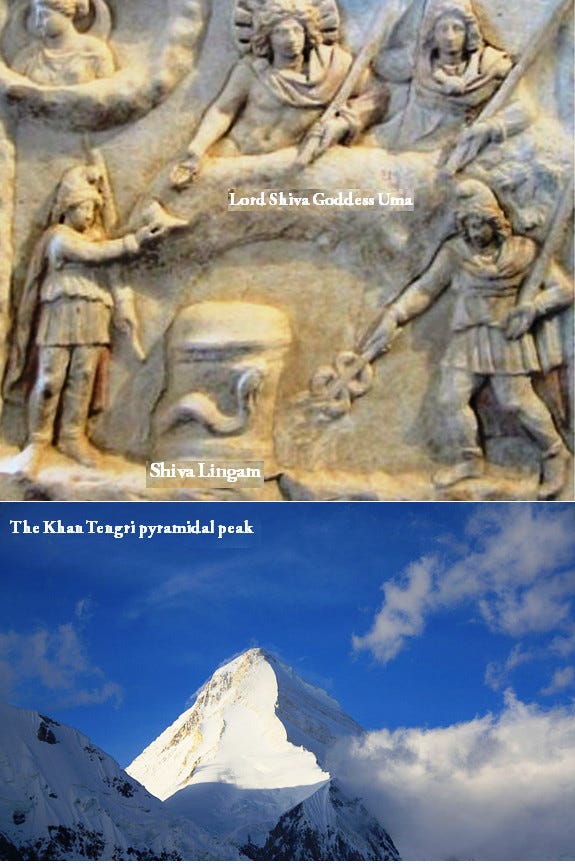TENGRISM and THE MONGOL EMPIRE
The religion of Genghis Khan, now revived in Kazakhstan & Kyrgyzstan
Tengrism is the national, "natural" religion of the Turkic peoples and these new flags indicate the importance of it to the people of Kazakhstan and Kyrgyzstan.
Internationally recognized, Kazakhstan became independent from the USSR on 16th December 1991.
This new flag was adopted on the 4th of June 1992 and is a pictorial image of the religion of Tengrism i.e., a sky blue background with an image of the sun and a stylised eagle representing freedom.
After Kyrgyzstan proclaimed its independence from the USSR on August 31, 1991 it introduced a new flag on March 3, 1992. The background of this flag is red, said to derive from a flag carried by the Kyrgyz national hero, Manas the Noble. In the centre of the flag is a yellow sun with 40 rays in memory of the followers of Manas and the tribes he united.
Kyrgyz means "we are forty" in the Kyrgyz language.
Tengrists aided Heraclius, who was the Emperor of the Byzantine Empire from 610 to 641, by reportedly sending 40,000 soldiers during a joint Byzantine-Göktürk operation against the Persians.
The additional detail of crossbars in the golden sun show the structure of a traditional yurt, the essential home for the horse loving, nomadic tribes of the region.
Tengrism is a fascinating and very old religion which is also known as Tengriism, Tenggerism, or Tengrianism.
It is a Central Asian religion characterised by shamanism, animism, totemism, poly and monotheism and featured the worship of ancestors.
It was the natural and ancient religion of the Mongols, Turks, Hungarians, Xiongnu and possibly the Huns.
It was also the religion of the five ancient Turkic states: Göktürk Khaganate, Western Turkic Khaganate, Great Bulgaria, Bulgarian Empire, and Eastern Tourkia (Khazaria). In Irk Bitig, Tengri is mentioned as Türük Tängrisi (God of Turks).
Tengrism has been reinvigorated in intellectual circles of the Turkic nations of Central Asia, including Tatarstan, Buryatia, Kyrgyzstan and Kazakhstan since the end of the Soviet Union and has a semi shamanic sun and sky worship style.
Still practiced today, it is undergoing a revival in Sakha, Khakassia, Tuva and other Turkic nations in Siberia. Burkhanism, a movement similar to Tengrism, is concentrated in Altay.
Khukh Tengri means "blue sky" in Mongolian.
Mongolians pray to Munkh Khukh Tengri, the Eternal Blue Sky and Mongolia is poetically referred to as the "Land of Eternal Blue Sky" (Munkh Khukh Tengriin Oron) by its inhabitants.
In modern Turkey, Tengrism is known as the Göktanrı dini, meaning the Sky God religion.
The Turkish words "Gök" (sky) and "Tanrı" (God) correspond to the Mongolian khukh (blue) and Tengri (sky), respectively.
Also, according to Hungarian archaeological research, Tengri was the religion of the early Hungarians until the end of the 10th century , before Christianity became popular there.
The Mongol Empire was the largest contiguous land empire in history which emerged from the unification of several nomadic tribes in the Mongol homeland under the leadership and control of Genghis Khan, who was proclaimed ruler of all the Mongols in 1206. Genghis Khan was born to a noble family and named Temüjin which means Man of Iron, some time around 1162.
He is both celebrated and denigrated all over the world but it very much depends on the perspective of the writer and their understanding of the history which impression you get. His reputation for extreme violence in the west is not matched by the reverence with which he is held in the East. His conquests laid the foundation for China’s Yuan dynasty (1271-1368) founded by his grandson Kublai Khan.
Genghis Khan attributed his success to Tengri and when he died on August 18, 1227 his body was buried in an unmarked location somewhere in Mongolia, the land of the eternal blue sky, at his request.
The Empire he left behind him was so huge that his grandsons later divided it between them into regions known as Khanates.
The vast transcontinental Mongol Empire connected the East with the West with an enforced Pax Mongolica, which encouraged the dissemination and exchange of trade, technologies, commodities and ideologies and thus the Tengri, sun and sky worship religion of the Golden Hordes of Genghis Khan was spread to people all over the Eurasian continent.
Tengrists believe there is only one supreme God.
His name is Tengri and he is unknowable.
He is aware of everything and knows everything.
So a lot of Mongols and Turks are often heard saying 'only Tengri knows.'
Tengriism believes there are many paths to God.
As Mongke Khan, the fourth great Khan said: "Just like Tengri gave man five fingers, he has also given different ways to reach God. If you are righteous in your thoughts and upright in your spirit, it doesn't matter which religion you follow. Tengri will accept you."
Tengriism is a non-dogmatic, monotheistic religion, born on the Central Asian steppes.
There is no one code in Tengriism, which was why it was able to attract so many people during the era of the Great Khan.
https://www.discovermongolia.mn/blog-news-the-ancient-religion-of-tengriism/
Here is a beautifully illustrated article which provides a little insight but mixes facts with supposition. I suppose it is difficult to write about such a hidden phase of history and a deeply suppressed religion as Tengri without some speculation.
https://www.linkedin.com/pulse/worship-tengri-sivkishen-ji
There is modern music named for the religion because it uses some traditional sounds like Mongolian throat singing.
There is even a London fashion brand and noble yarn specialists which was built by people pioneering a new heritage. They sell luxury clothing which uses yarns and fibres from the traditional nomadic lifestyle of Mongolia.











Modern Mongolia is an amazing experience!
https://youtu.be/NRipDEuuiyg?si=7XeD0vhe1PwfLvkb
Hu in live concert at Hellfest 2023:
https://youtu.be/TlfzQaNlSxo?si=zAxAfZeg89bg9nuC